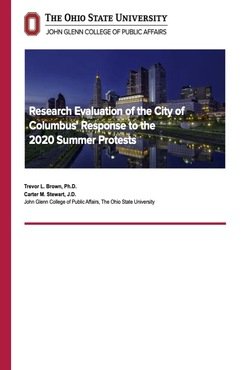Research Evaluation of the City of Columbus' Response to the 2020 Summer Protests
By Trevor L. Brown and Carter M. Stewart
The murder of George Floyd, a Black man, by Derek Chauvin, a White Minneapolis, Minnesota, police officer on May 25, 2020, sparked months-long protests about racism and policing across the country and around the globe, including Columbus, Ohio. Captured on video and spread quickly through social media, Floyd’s death galvanized Americans to take to the streets in the midst of a global health pandemic to voice their anger and frustration about the many Black Americans who had been killed by police. The fairness of policing practice as applied to communities of color, particularly Black communities, and more fundamentally, the existence of the police as a legally sanctioned public institution were the clear motivations for the protests. Law enforcement agencies across the country, including the Columbus Police Department, also mobilized to the streets. Their job was to create a space for citizens to peacefully exercise their right to free speech, while simultaneously ensuring the safety of the community. In many protests, police are neutral actors managing the boundaries of the demonstration. In the protests of 2020, protestors saw the police as antagonists, and systematically racist; they were the object of the protest. When police are the focus of the protest, there is a significant increase in the likelihood of direct conflict between protestors and law enforcement personnel. Adhering to best practice in protest management and adapting to evolving protest dynamics become even more important to ensure free speech rights and community safety. This report provides the results of an
-
eight-month research study evaluating how the City of Columbus, Ohio, inclusive of elected officials and the Columbus Division of Police (CPD), managed the protests in Columbus from May 28 through July 19, 2020.
Columbus, OH: John Glenn College of Public Affairs, The Ohio State University, 2021. 111p.


